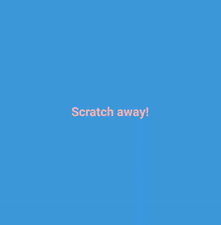Scratchoff
A simple library for implementing scratchable Views.
Installation
repositories {
jcenter()
}
dependencies {
compile('com.jackpocket:scratchoff:1.1.0')
compile 'com.android.support:support-v4:23.4.0'
}
Usage
The goal of this library is to create a scratchoff interface. By storing and manipulating the drawing cache of a View, we can create the effect of scratching it away to reveal what's hidden below.
First, you need a RelativeLayout (to align layouts on top of one another) consisting of 2 sub-layouts, a behind-View and the View to be scratched away from the foreground. Here is a simple example using the ScratchableLinearLayout:
<RelativeLayout
android:layout_width="match_parent"
android:layout_height="match_parent" >
<RelativeLayout
android:id="@+id/scratch_view_behind"
android:layout_width="fill_parent"
android:layout_height="fill_parent"
android:background="#818B8D" >
<ImageView
android:layout_width="fill_parent"
android:layout_height="wrap_content"
android:layout_centerInParent="true"
android:layout_margin="25dip"
android:adjustViewBounds="true"
android:src="@drawable/some_drawable_to_be_revealed" />
</RelativeLayout>
<com.jackpocket.scratchoff.views.ScratchableLinearLayout
android:id="@+id/scratch_view"
android:layout_width="fill_parent"
android:layout_height="fill_parent"
android:background="#3C9ADF" >
<ImageView
android:layout_width="fill_parent"
android:layout_height="wrap_content"
android:layout_gravity="center"
android:adjustViewBounds="true"
android:gravity="center"
android:src="@drawable/some_top_drawable" />
</com.jackpocket.scratchoff.views.ScratchableLinearLayout> </RelativeLayout>Note: be careful with the dimensions of both the behind-View and the foreground View. The ScratchableLayoutDrawer will attempt to set the foreground View's LayoutParam width and height attributes to match that of the behind-View so that their dimensions line up perfectly.
Now that you have a layout, we need to attach the ScratchoffController to it:
ScratchoffController controller = new ScratchoffController(context)
.setThresholdPercent(0.40d)
.setTouchRadiusDip(context, 30)
.setFadeOnClear(true)
.setClearOnThresholdReached(true)
.setCompletionCallback(() -> {
}
)
.attach(findViewById(R.id.scratch_view), findViewById(R.id.scratch_view_behind));
In this example, you only need the constructor and the attach(View, View) method to enable scratching. The default values for all the other methods are configurable by overriding the appropriate resources.
Since the foreground View in our example is a ScratchableLinearLayout (which implements ScratchableLayout), the ScratchoffController will automatically attach itself to the View and drawing will work correctly (the same goes for the ScratchableRelativeLayout).
Please note: If you're not using one of the supplied ScratchableLayouts, you must manually call ScratchoffController.draw(Canvas) from your custom View's onDraw(Canvas) method.
Re-using the ScratchController
With version 1.0.2, the ScratchController can be correctly reset using ScratchController.reset(), but you must set the background color of your ScratchableLayout back to something opaque before calling it, as the ScratchableLayoutDrawer must set it to transparent afterwards in order to efficiently process scratched paths. e.g.
controller = new ScratchoffController(this)
.setCompletionCallback(() ->{
findViewById(R.id.scratch_view)
.setBackgroundColor(0xFF3C9ADF);
// Make sure to set the background. Don't worry, it's still hidden if it cleared
new Handler(Looper.getMainLooper())
.postDelayed(() ->
controller.reset(), 2000);
}
)
.attach(findViewById(R.id.scratch_view), findViewById(R.id.scratch_view_behind));
Lifecycle
As a final note, if using the ScratchoffController in the context of an Activity, you may want to also ensure you call the correct lifecycle methods for onPause(), onResume(), and onDestroy() as needed, to ensure the processors will stop/restart and not run needlessly in the background. e.g.
@Override public void onPause(){
controller.onPause();
super.onPause();
}
@Override public void onResume(){
super.onResume();
controller.onResume();
}
@Override public void onDestroy(){
controller.onDestroy();
super.onDestroy();
}
Since version 1.1.0, the processors will stop if ViewCompat.isAttachedToWindow(View) returns false for whatever scratchable layout the controller was attached to (that's why there's now a support package dependency...).
